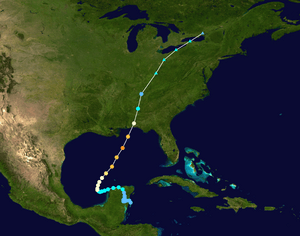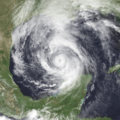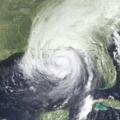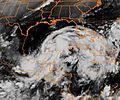Hurricane Opal facts for kids
| Category 4 major hurricane (SSHWS/NWS) | |
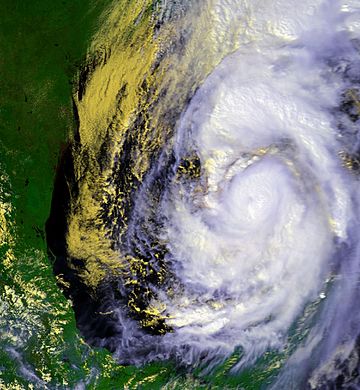
Hurricane Opal in the Gulf of Mexico
|
|
| Formed | September 27, 1995 |
|---|---|
| Dissipated | October 6, 1995 |
| Highest winds | 1-minute sustained: 150 mph (240 km/h) |
| Lowest pressure | 916 mbar (hPa); 27.05 inHg |
| Fatalities | 59 direct, 10 indirect |
| Damage | $3.9 billion (1995 USD) |
| Areas affected | Guatemala, Yucatán Peninsula, Alabama, Florida Panhandle, Georgia, most of eastern North America |
| Part of the 1995 Atlantic hurricane season | |
Hurricane Opal was a very strong hurricane that started in the Gulf of Mexico in September 1995. It was the ninth hurricane of the 1995 Atlantic hurricane season. Opal became the strongest hurricane of that year.
The storm first crossed the Yucatán Peninsula as a weaker tropical depression on September 27. It then grew much stronger as it moved north in the Gulf. Opal became a powerful Category 4 Atlantic hurricane. On October 4, it hit the Florida Panhandle near Pensacola. At that time, its winds were about 125 miles per hour (201 km/h).
Hurricane Opal caused a lot of damage in the Pensacola and Panhandle areas. It brought a huge storm surge of 15 feet (5 meters). The storm then traveled across Alabama, becoming a tropical storm when it reached Tennessee. Opal also caused heavy damage in the mid-Atlantic states before it finally faded away. Sadly, 50 people died from flooding caused by Opal in Guatemala and Mexico. Another 13 people died in the United States because of the storm. The total cost of the damage was estimated to be around $3 billion.
Contents
How Hurricane Opal Formed
The story of Hurricane Opal began with a tropical wave that moved away from Africa on September 11. This wave disappeared into a low pressure area in the Caribbean Sea a few days later.
However, the wave was found again on September 27. It had become strong enough to be called Tropical Depression Eighteen. This tropical depression soon made landfall in the Yucatán Peninsula. On September 30, Tropical Depression Eighteen grew stronger and became Tropical Storm Opal.
Tropical Storm Opal continued to move west until October 2. On that day, it changed direction and turned northeast. It also became much stronger, turning into Hurricane Opal.
Opal's Strength and Path
Hurricane Opal grew very quickly. Just two days after becoming a hurricane, on October 4, it reached its top wind speed of 150 miles per hour. This made it a powerful Category 4 hurricane.
Hurricane Opal continued moving northeast. It weakened a little before making its final landfall on Santa Rosa Island, Florida, on October 4. At that time, it was a Category 3 hurricane.
As Hurricane Opal moved over central Alabama, it weakened to a tropical storm. It did not become a tropical depression until it reached Tennessee. Finally, on October 5, Tropical Depression Opal changed into an extratropical cyclone over the Ohio River Valley and disappeared.
Why the Name "Opal" Was Retired
After the 1995 hurricane season, the name "Opal" was officially retired in the spring of 1996. This means that no future Atlantic hurricanes will be named Opal. Hurricane names are retired when a storm causes a lot of damage or deaths. This is done to prevent confusion and to show respect for the victims.
Instead of "Opal," the name "Olga" was chosen to be used in the future. "Olga" was first used in 2001 and again in 2007. It could be used again in hurricane seasons like 2013.
Related Information
Images for kids
-
Hurricane Opal rapidly intensifying in the Gulf of Mexico on October 3
-
Hurricane Opal near landfall in Pensacola, Florida as a Category 3 hurricane
See also
 In Spanish: Huracán Opal para niños
In Spanish: Huracán Opal para niños


